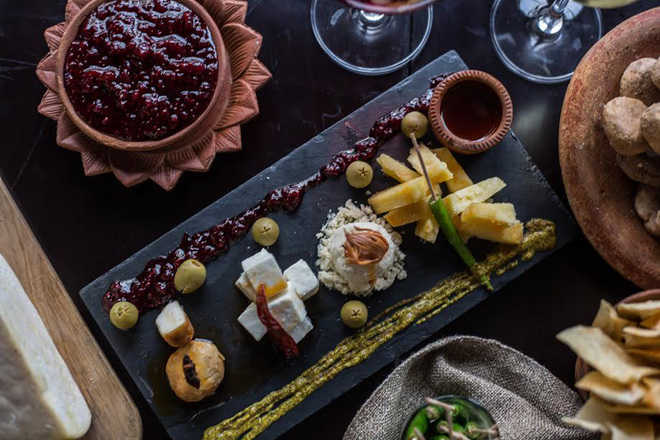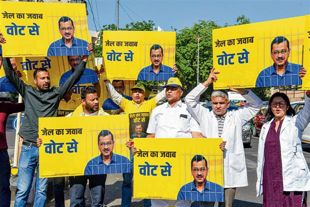
Designer touch: Chef Saby’s desi cheese platter is a foodie’s delight
Purnima Sharma
Having long enjoyed its position as the only (recognisable) local cheese, the paneer now has competition — as several ‘new’ indigenous varieties of cheese are making their presence felt on the foodie smorgasbord. “With the Indian gourmet turning adventurous — not just to enjoy international flavours but also to partake of new local experiences — the variety of desi cheese, from Kalimpong to Kutch, is enjoying a never-before favour with them,” says Sabyasachi aka chef Saby, a food creator par excellence.
“India is not known for its cheese — like the way many European countries are. But things are likely to change, what with the interesting array that has sprung up,” says the chef-mentor, who has been using a variety of local fare, including the Manali mozzarella and cheese, from Kutch, Kalimpong, Pondicherry and Kodaikanal in his food preparations. “The cheese platter I create using these is greatly relished,” smiles Saby. And what makes it worthwhile is that people are responding to these preparations in a big way, he adds remembering how the mascarpone (Indian) cheese he was making at Olive restaurant was so popular. “It gives you a sense of pride because something so tasty and healthy has been made in your own country,” he says.
Conceding that some people may sometimes feel that this local fare may not be as good as the classical stuff from Europe, “but what they need to realise is that these cheeses also have their own quintessential character (in the sense that these are unripe and don’t have animal rennet that helps in cheese maturation) in them”.
The “Indian-flavoured cheese” has been the calling card of Mussoorie’s Prakash Store for more than 70 years now — from the time a young Jawaharlal Nehru would stop by to pick up cheese and jam whenever he visited the hill station. Today, the store’s coveted ‘Mussoorie cheese’ has a market across the country.
“It’s not just old-timers and connoisseurs of indigenous cuisine who ask for it, but even youngsters who want to try it out,” says the second-generation owner of the store, Anil Prakash, whose parents were both experts in the art of making cheddar cheese. Talking about the essential flavour of his cheese, he says, “It mostly comes from the local milk and the vegetarian rennet (enzyme used to coagulate the milk) we use. Few cheesemakers have the advantage that we, the ones in the hills, have,” says Prakash, referring to his organic milk and the natural way the cheese is allowed to mature from one-and-half months to a year.
Yet another popular variety of indigenous cheese that is finding its way to the gourmet’s platter, courtesy the efforts of Chris Zandee, is the kalari cheese. Working with the Gujjars and Bakerwals of Jammu and Kashmir, the Dutchman, who landed in Pahalgam in 2007, was determined to bring this staple food into the mainstream.
“Initially, even the locals weren’t open to the idea,” he says. “That’s because no one thought it was hygienic enough, given the living conditions of its makers.”
But once Zandee started supervising kalari production according to hygienic norms, things started looking up. Made from water-buffalo and cow milk, the kalari, says Zandee, “which is more like the mozzarella since it’s a soft and stretched cheese” is finding markets across India. “It’s getting shipped directly to five-star hotels and food-lovers’ homes. Retail shops still seem to be wary of Indian cheese,” feels Zandee.
Even at this pace, his company’s sales have zoomed up by about 200 to 300 per cent since they started. “I guess what’s also helped is that this is a lean, low-fat content cheese that can also be eaten raw or grilled, with salads,” he adds.
Indigenous cheese that comes from the hills is both interesting and unusual in taste, asserts Aditya Raghavan, a Mumbai-based cheese consultant.
In 2013, having gained “some experience at cheese farms in Canada”, Raghavan bid adieu to academics and returned home “to a country that could easily be the No.1 producer and consumer of milk”. Once here, he realised that “making cheese was not a great skill set among its people”.
Now, with more than nine clients, including “small farms in Kochy and Bengaluru, who want to add value to their goat milk”, the physicist-turned-agronomist’s main job is to help them make western style cheddar, brie and feta cheeses, among others, with local ingredients. However, he asserts that India’s cheese platter contains a lot more varieties. Raghavan is talking not just about kalari, but also the churpi — both soft and hard varieties — that comes from different Himalayan pockets, including areas of Sikkim; the Kalimpong cheese made of cow and yak milk from areas around Darjeeling, bandel that originates from the eponymous village that was once a Portuguese colony near Kolkata; and topli nu paneer, a Parsi delicacy, among others.
With these indigenous varieties of cheese slowly making their presence felt, Raghavan says greater efforts are needed by foodies to create awareness about them. “I keep writing about these in my blogs to get people excited enough to start connecting cheese with brands other than Amul or the ones coming from Europe,” he says, hoping that chefs start creating attractive recipes around these too.
Chef Saby agrees, “These cheeses were not planned to be table food but were created to be used mostly in cooking.” While he enjoys working with kalari, Raghavan enjoys the versatility of the churpi. “I am not talking of the hard one that is also called ‘doodh supari’ because of its hard exterior but the soft variety,” he says and goes on to mention how people in the North-East often use it to make a chutney that tastes “really cool with momos. Even a stir-fry topped with churpi is great”, he smiles. The bandel variety, according to him, has a long shelf-life but is extremely salty. “So, it makes for good salad dressing. Chefs like Namit Chandra use it for their salad platters,” informs Raghavan, whose personal favourite is the kalari he that uses to make a fondue or “having it simply by melting it over toast”.
The jelly-like topli nu paneer, although relished by the Parsis, is still to find favour with other communities. “It needs to be played around with,” says Raghavan giving the example of chef Thomas Zacharias of The Bombay Canteen, who uses topli nu paneer to garnish his maa-ki-dal.
Bangalore-based Manu Chandra, chef partner, Toast & Tonic, has been using indigenous chhenna and Bangalore mozzarella cheese for more than a decade.
The piece would be incomplete without a mention of camel cheese that is now being promoted by a Rajasthan-based NGO. Anne Bruntse, who recently held a camel cheese-making workshop in Delhi, said camel cheese would help combat health problems like diabetes, autism and ulcers. Although it is not yet produced in a big way, “its production needs to be given a boost and recipes created”, adds the Kenya-based Danish agronomist.


























